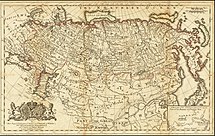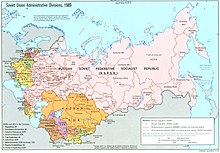
Back Rikisi no Rosiya AMI تاريخ روسيا Arabic Historia de Rusia AST Rusiya tarixi AZ Рәсәй тарихы BA Гісторыя Расіі BE История на Русия Bulgarian রাশিয়ার ইতিহাস Bengali/Bangla Istor Rusia BR Historija Rusije BS
| History of Russia |
|---|
 |
|
|




The history of Russia begins with the histories of the East Slavs.[1][2] The traditional start date of specifically Russian history is the establishment of the Rus' state in the north in 862, ruled by Varangians.[3][4] In 882, Prince Oleg of Novgorod seized Kiev, uniting the northern and southern lands of the Eastern Slavs under one authority, moving the governance center to Kiev by the end of the 10th century, and maintaining northern and southern parts with significant autonomy from each other. The state adopted Christianity from the Byzantine Empire in 988, beginning the synthesis of Byzantine and Slavic cultures that defined Russian culture for the next millennium. Kievan Rus' ultimately disintegrated as a state due to the Mongol invasions in 1237–1240. After the 13th century, Moscow emerged as a significant political and cultural force, driving the unification of Russian territories. By the end of the 15th century, many of the petty principalities around Moscow had been united with the Grand Duchy of Moscow, which took full control of its own sovereignty under Ivan the Great.
Ivan the Terrible transformed the Grand Duchy into the Tsardom of Russia in 1547. However, the death of Ivan's son Feodor I without issue in 1598 created a succession crisis and led Russia into a period of chaos and civil war known as the Time of Troubles, ending with the coronation of Michael Romanov as the first Tsar of the Romanov dynasty in 1613. During the rest of the seventeenth century, Russia completed the exploration and conquest of Siberia, claiming lands as far as the Pacific Ocean by the end of the century. Domestically, Russia faced numerous uprisings of the various ethnic groups under their control, as exemplified by the Cossack leader Stenka Razin, who led a revolt in 1670–1671. In 1721, in the wake of the Great Northern War, Tsar Peter the Great renamed the state as the Russian Empire; he is also noted for establishing St. Petersburg as the new capital of his Empire, and for his introducing Western European culture to Russia. In 1762, Russia came under the control of Catherine the Great, who continued the westernizing policies of Peter the Great, and ushered in the era of the Russian Enlightenment. Catherine's grandson, Alexander I, repulsed an invasion by the French Emperor Napoleon, leading Russia into the status of one of the great powers.
Peasant revolts intensified during the nineteenth century, culminating with Alexander II abolishing Russian serfdom in 1861. In the following decades, reform efforts such as the Stolypin reforms of 1906–1914, the constitution of 1906, and the State Duma (1906–1917) attempted to open and liberalize the economy and political system, but the emperors refused to relinquish autocratic rule and resisted sharing their power. A combination of economic breakdown, mismanagement over Russia's involvement in World War I, and discontent with the autocratic system of government triggered the Russian Revolution in 1917. The end of the monarchy initially brought into office a coalition of liberals and moderate socialists, but their failed policies led to the October Revolution. In 1922, Soviet Russia, along with the Ukrainian SSR, Byelorussian SSR, and Transcaucasian SFSR signed the Treaty on the Creation of the USSR, officially merging all four republics to form the Soviet Union as a single state. Between 1922 and 1991 the history of Russia essentially became the history of the Soviet Union.[opinion] During this period, the Soviet Union was one of the victors in World War II after recovering from a surprise invasion in 1941 by Nazi Germany and its collaborators, which had previously signed a non-aggression pact with the Soviet Union. The Soviet Union's network of satellite states in Eastern Europe, which were brought into its sphere of influence in the closing stages of World War II, helped the country become a superpower competing with fellow superpower the United States and other Western countries in the Cold War.
By the mid-1980s, with the weaknesses of Soviet economic and political structures becoming acute, Mikhail Gorbachev embarked on major reforms, which eventually led to the weakening of the communist party and dissolution of the Soviet Union, leaving Russia again on its own and marking the start of the history of post-Soviet Russia. The Russian Soviet Federative Socialist Republic renamed itself as the Russian Federation and became the primary successor state to the Soviet Union.[5] Russia retained its nuclear arsenal but lost its superpower status. Scrapping the central planning and state-ownership of property of the Soviet era in the 1990s, new leaders, led by President Vladimir Putin, took political and economic power after 2000 and engaged in an assertive foreign policy. Coupled with economic growth, Russia has since regained significant global status as a world power. Russia's 2014 annexation of the Crimean Peninsula led to economic sanctions imposed by the United States and the European Union. Russia's 2022 invasion of Ukraine led to significantly expanded sanctions. Under Putin's leadership, corruption in Russia is rated as the worst in Europe, and Russia's human rights situation has been increasingly criticized by international observers.
- ^ "History of Russia – Slavs in Russia: from 1500 BC". Historyworld.net. Archived from the original on 9 March 2006. Retrieved 14 July 2016.
- ^ Hosking, Geoffrey; Service, Robert, eds. (1998). Russian Nationalism, Past and Present. Springer. p. 8. ISBN 9781349265329.
- ^ Grey, Ian (2015). Russia: A History. New Word City. p. 5. ISBN 9781612309019.
- ^ Ketola, Kari; Vihavainen, Timo (2014). Changing Russia? : history, culture and business (1. ed.). Helsinki: Finemor. p. 1. ISBN 978-9527124017.
- ^ Article 1 of the Lisbon Protocol from the U.S. State Department website. Archived 28 May 2019 at the Wayback Machine